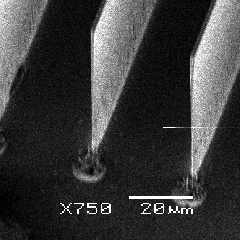Deep Reactive Ion Etching (DRIE) has in recent years become a dominant technique for the prototyping and manufacture of silicon micro-electro-mechanical systems (MEMS). With the maturing of DRIE and the denser packing of devices on to wafers has come a need to understand and control spatial variations of the etch rate. In addition to well-known feature size or aspect ratio-dependent etch (ARDE) non-uniformity, etch rate can vary between regions of the wafer, such that supposedly identical MEMS fabricated on that wafer may vary in performance or fail in use. Wafer-scale uniformity and inter- and intra-device consistency may be improved by changing conditions in the etching chamber, but this usually compromises etching speed and may accentuate ARDE.
An alternative approach is to lay out the patterns being etched so that they compete for reactants in a controlled way. To this end, we have demonstrated a way of pre-characterizing any DRIE tool plus associated 'recipes' of operating parameters. Several test wafers are etched and measured, and simple data-fitting algorithms are run. The model constructed captures etch non-uniformity occurring over the diameter of a wafer, plus variations caused by the localization of patterns within the wafer. Our technique has been shown to model etch rate variation across experimental wafers with fitting errors of less than 5% r.m.s. per wafer.
Our model can then predict etch rates across a wafer for any mask design. A prediction takes only a few seconds to compute using Matlab, and we envisage our prediction method being integrated into computer-aided MEMS design systems. Such systems could either guide engineers or automatically insert non-functional regions of etched silicon to perturb etch rates constructively.
We are now engaged in a collaboration to define a standard DRIE test pattern and integrate ARDE models with our existing wafer- and die-scale simulation approach.
In addition to pattern-dependent variations of etch rate, we have observed temporal variations whereby the design of an etched pattern influences the rate and uniformity with which a subsequent wafer etches. Such 'memory' effects within the tool diminish over minutes, but could be important when using DRIE for production runs of many devices. We are applying existing test patterns to quantify these temporal variations and to understand exactly how fluxes of monatomic fluorine radicals and SxFy ions interact to determine DRIE rate and uniformity.


